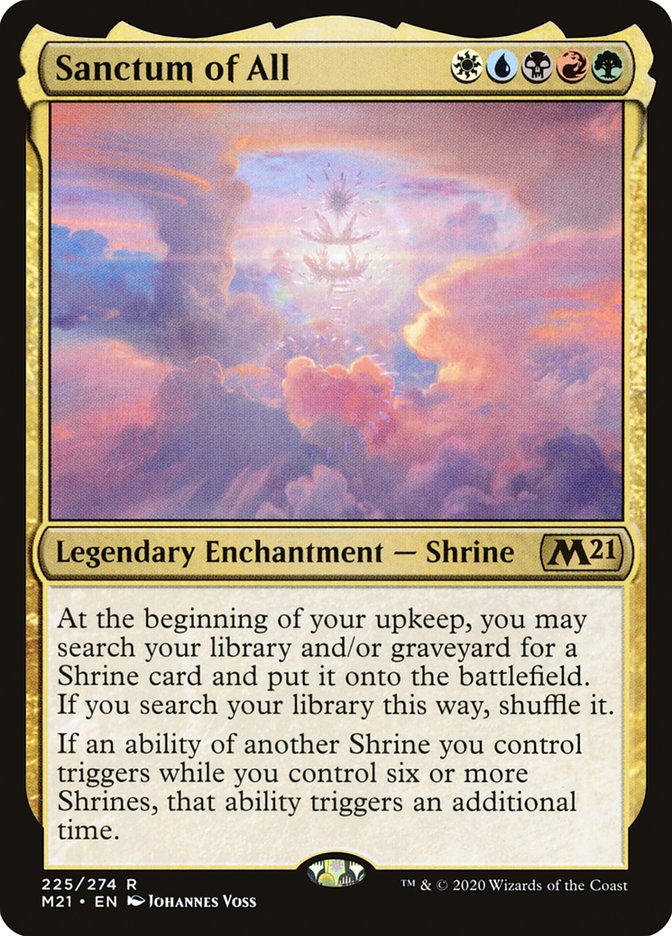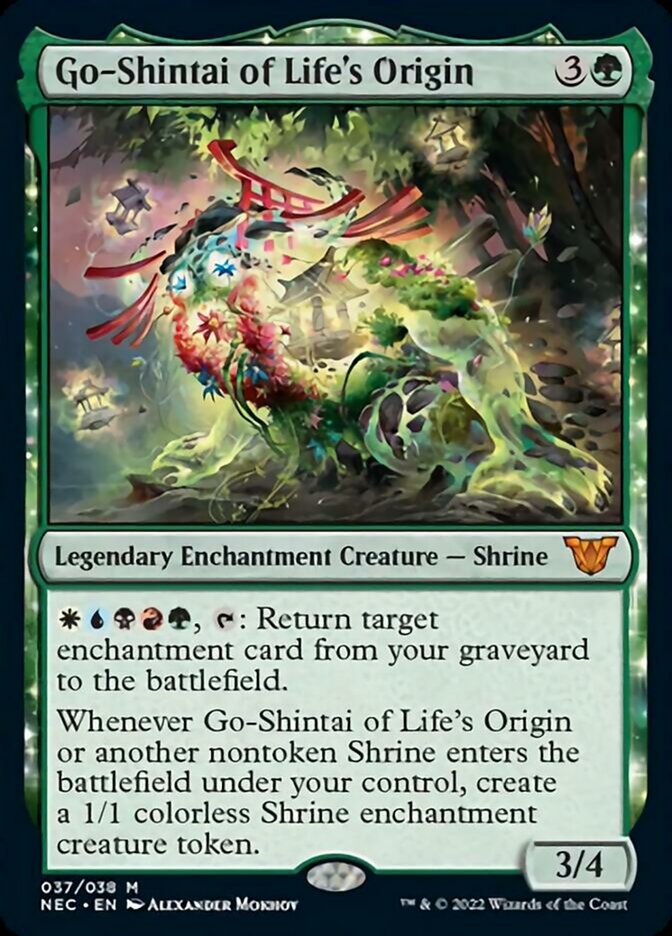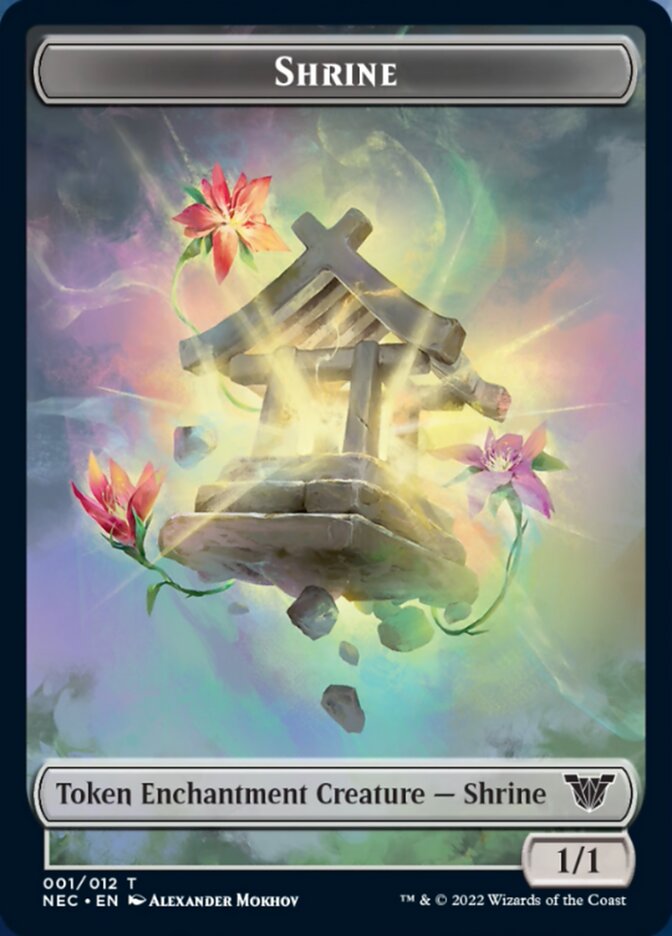Shrines have been around for a bit, a cycle originally in Champions of Kamigawa, then a return in Core Set 2021. Finally, the return to Kamigawa in Kamigawa: Neon Dynasty saw another cycle of shrines. The second and third cycles each included an extra “bonus” 5- color shrine.
I find them attractive because I think they’re just kind of neat, and I keep trying to make enchantress decks work in commander, and generally they kind of lack. There are certainly enchantress decks that do well, but they tend to be a bit slow and often stall out. Enchantress decks typically rely on ramp that’s enchantments and then playing enchantresses, but then you’ve used up your enchantment ramp which you need to also get your card draw going. If you don’t get the right mix of cards, ramp and enchantresses and some cheaper utility enchantments to start snowballing they easily stall out. You can’t run too many lands or you’ll get all lands, but you often use cards like Wild Growth and Fertile Ground to ramp while being enchantments, but then it’s easy to end up in scenarios where you have way to many lands and enchantment ramp without enchantresses, or too many enchantresses who aren’t enchantments, or just not quite enough lands. Still, I persevere.
Shrines are another attempt at an enchantress deck, one with some interesting twists due to the unique nature of shrines themselves. Each cycle has a naming convention, each cycle has a triggered timing (though cycle 2 has some exceptions) and each one cares about shrines, i.e. the number of cards with the subtype shrine that you have in play. Shrines don’t care about cards called shrine, like Cabal Shrine or Godless Shrine. Shrine is an enchantment subtype, not a creature subtype, even if you end up with a creature with the type shrine (which is pretty likely in this deck).
So there’s some powerful effects there and then there’s some less powerful effects there.
The 2 “bonus” 5 color cards are important too, one is our commander and one does a ton of heavy lifting.

So Sanctum of All will fetch more shrines, and if you hit 6 shrines in play it will cause other shrines effects to double (but not itself). That’s fairly big. If you can land this early you will be able to just keep grabbing shrines and popping them into play, and your board state should rapidly just become completely overwhelming. You can also stack your upkeep triggers to take full advantage of this, put any other upkeep shrines on the stack first, then the Sanctum of All trigger; this way the Sanctum of All will resolve first, and you’ll have one more shrine in play for the other shrine. Also you generally will want to search for a main phase or end step shrine, since the upkeep triggers for that turn will have already passed, so you won’t be able to get that shrines trigger this turn if you search for an upkeep shrine. That being said, if what you need is an upkeep shrine, go for it.

This is our commander, also a shrine, also a creature, also creates tokens, also able to return enchantments from the graveyard to the battlefield, which is a totally new thing (and its triggered token creation will trigger when you “reanimate” a shrine, whether it’s a creature or not) which also means that if you react to a bunch of shrine triggers going onto the stack during your upkeep, and reanimate a shrine before the shrine triggers have resolved, you’ll get +2 shrines for that round of shrine triggers (one from the reanimated shrine, one from the token).
Tokens you say?

These tokens are kind of odd. Technically they have no creature type (maybe Nameless Race is a shrine to… namelessness). They are enchantment creatures, and they count as shrines, but shrine isn’t a creature type. You can’t do various things that cause things to become a creature type to get more shrine triggers (this would potentially be dangerous).
The trouble with a deck like this is is 5-color and so you need a really expensive mana base or proxies, and you’ll definitely at times struggle to have the right lands. It also runs some stax effects since it is basically artifact-less, Stony Silence and Collector Ouphe are powerful and cheap inhibitors against many decks, and can completely shut down some decks.
There are a few different ways to go with a deck like this. One approach would be just to include every shrine, that’s 16 cards and the commander out the gate. Maybe run some elves for ballast and ramp, and some land ramp, and use green to mana fix. Run the enchantress suite of about 7 cards and just hope to draw into shrines.
Given the Go-Shintai of Life’s Origin’s ability to reanimate shrines and make tokens, I think it’s a lot more fun to make this a kind of reanimator deck. There’s another kind of enchantment that often ends up in your graveyard – Sagas. Granted there’s not a lot of Sagas that work particularly well in the commander 4-player environment, like Planeswalkers they are often sort of underwhelming in multiplayer. Even so there are a few solid ones that can be put into play and then reanimated if they run out of counters for even more shrine tokens.
You could also build this as some kind of combo deck, using Intruder Alarm and Go-Shintai of Life’s Origin reanimation ability with a sac outlet to endlessly reanimate the same enchantment over and over. Some enchantments themselves can be sacrificed to create this loop easily (for example you can target a Seal of Cleansing with itself, the ability will fail as the target is no longer there, but that will let you endlessly reanimate the Seal, assuming you have infinite mana of every color… which is a lot to get – or are generating 5 per enters play trigger). Frankly, that’s a long way to go in my opinion to do a combo like that, if you want to combo out there are easier ways.
Instead, I think the reanimation factor lets you really play up the fact that there are 5 colors in the deck. Graveyard tutor effects let you stash shrines or enchantresses or sagas and then reanimate them. This gives you a toolbox approach to the game.
Generally, you will probably want to be careful with something like this, as you can snowball pretty badly but also can just be rushed out. Do not rush out something that does a lot of damage or drains life. Sanctum of Stone Fangs is a very powerful effect, but unless your life total is being pressured you probably don’t want to get it out early. If you do, you will almost certainly find your life total being pressured as you become table enemy and threatening.
Generally I’d recommend grabbing first one of the blue shrines to get card draw, then Sanctum of Fruitful Harvest for mana ramp, then Sanctum of Shattered Heights for some control. If you think you can protect it rush out Sanctum of All, but if it makes you too scary, then uh, don’t. You’ll have to judge this carefully based on your meta and your opponents, some players will know the power of Sanctum of All, especially if you manage to land something like Paradox Haze.
Like with virtually any deck you want to get into a position to win then win quickly. This can be a tough balancing act, but you can use the reanimation effect to get a couple shrines out right before your turn, then more shrines via Sanctum of All. Also if you can do something cute like reanimate Paradox Haze or even eventually Sphinx of the Second Sun you can easily deal a ton of damage and draw a ton of cards in one turn. Geometric progressions get completely out of control.
Here is, Enshrined Life:
I’m going to try this deck out soon and I may report back on my findings.
Next week will be our staged New Cappena analysis.


